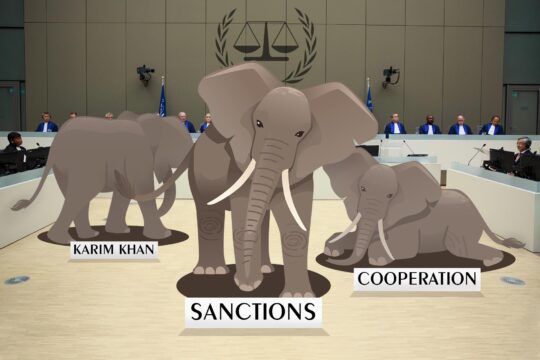“I’d like to start with the criticisms we’ve received and which we have carefully analysed,” said former judge and Recognition and Reparation Commission (CRR) president Antoine Garapon, who has chosen to echo a newly published report at a one-day review meeting on December 12, 2024 at the Facultés Loyola in Paris. He was speaking to some 150 people at the event to address criticisms “of this unique restorative justice experience”.
The CRR was created as an association on October 26, 2021, by a vote of the General Assembly of the Conférence des religieux et religieuses de France (CORREF). The time had come for individualized reparations as recommended by the Independent Commission on Sexual Abuse (CIASE). In a damning report, CIASE had given the figure of 330,000 victims of sexual abuse by members of the clergy and laity working in Church institutions between 1950 and 2020. The CRR was set up in response to this need for restorative justice for men and women who have been victims of sexual violence committed by members of religious congregations in France.
Between 2022 and 2024, 1,027 people effectively referred cases to the CRR, but it issued only 475 financial recommendations. “The discrepancy can be explained by suspended cases (due to legal action), people wishing to testify without financial reparation, and cases that have lasted a long time due either to the victim or the congregation,” explains Anne de Ricoeur, the Commission’s head of operations. “Between when the case is referred and a recommendation issued, support to the victim lasts an average eight to 15 months, taking the time the victim needs. In some cases, it can take up to two years,” she adds.
Cases involving priests affiliated to a diocese of the Catholic Church and not to a congregation are deemed inadmissible. These cases are transferred to the Instance nationale indépendante de reconnaissance et réparation (INIRR) without the victim having to make a new referral. The CRR does not deal with non-sexual abuses, those committed by communities or associations that are not members of CORREF, by lay people working in the Church, or by members of foreign congregations.
16.4 million euros paid to victims
In three years, out of the 70% of referrals where the CRR was competent, the 25 commissioners have listened to hundreds of victims. At the end of each interview, a questionnaire is given to those interviewed, with a view to assessing repercussions, requesting reparations and proposing the amount of financial compensation. Their case is then studied by the CRR, which issues financial and other recommendations for the congregations.
Between October 2021 and December 2024, 16.4 million euros were paid out to victims, with the average compensation recommendation being 34,500 euros. “The ceiling of 60,000 euros is perhaps a little low,” says Garapon. “But I wanted the system to be sustainable. Some victims don’t ask for money because they feel it would ‘confuse their approach’, but financial reparation is generally unavoidable. “It allows you to see the seriousness of what happened to you, and that’s very important. In reality, an unwanted kiss is certainly an aggression but it is not the same as a 10-year-old boy being sodomized. We have nevertheless found that there is very deep damage done to a man or woman who has ‘just’ been kissed against their will in a monastery, for example.”
Delphine Griveaud, author of a thesis (2016-2022) on restorative justice practices in France, believes that the CRR is breaking new ground. “It is the first restorative justice instance where there is symbolic but also material reparation,” she says. “This is not done in restorative mediations controlled by the judicial authority.” Since restorative justice was included in French law in 2014, it has developed in the criminal field through various practices (mediations, meetings between prisoners and victims, restorative or support circles).
After listening, symbolic reparations
In the CRR’s restorative process, so-called “symbolic” reparations supplement the money paid to victims, for example: receiving a letter from the congregation in which the abuse is acknowledged; planting a tree at the scene of the tragedy; exchanging gifts between the congregation and the victim; or attending memorial days or acts. A writing workshop was also organized, and a first-of-its-kind book, “Quand le diable a revêtu l'habit” (“When the Devil Wore the Habit”) was published, written by eleven victims bearing witness.
“The most desired reparation is to meet a member of the congregation, to say or retell what happened, face to face. Victims want a kind of physical, almost sensory recognition -- to be looked at, to be told 'I believe you, the aggressor did exist, he did you harm'. It’s a very powerful moment,” says Véronique Le Goaziou, a sociologist specializing in delinquency and sexual violence. In 2023, she was contacted by the CRR, “to study, with the eye of an outsider, what the commission was doing”. “They needed someone who wasn’t from the CRR, nor from the religious world, but who was familiar with the issue of sexual violence,” she explains.
Her report “Repairing Victims”, financed by the CRR and published in December 2024, reports on the perceptions and feelings of victims who have passed through the commission. This sociologist studied several hundred victims’ files. “With a doctoral colleague, we then conducted 55 interviews, asking three questions: before going to the CRR, where did you stand in relation to the violence you suffered - by which I mean had you already spoken about it? How would you describe the CRR process? And how was this experience for you?”
Triple impact
Le Goaziou says she was struck by “the unanimity of opinion on the benefits of the approach”, having expected “much more criticism and possibly some acerbic comments or disappointment”. She acknowledges that some victims pointed to limitations, but “none of the 55 people consulted questioned the restorative justice approach or the existence of the CRR”.
In her report, she stresses that most panel members “felt a strong sense of empathy from the commissioners [...], sensitivity, kindness, thoughtfulness, patience and gentleness, which gave them an incredible sense of well-being and contrasted with the coldness and harshness of those involved in the Church or their entourage”. People also stressed the importance of listening, as this victim testifies: “It was the first time I’d spoken about it; I wasn't sure who I was sending the e-mail to, whether they were going to take me seriously, and I had no idea where I was going.” But this victim’s word “has never been denigrated, questioned or challenged”.
The sociologist also analyses the positive impact of the spoken word, not only that of the victims who testify and are listened to, but also that of the commissioners. “The commissioners’ ‘I believe you’ has a triple impact. It acknowledges the facts and attests that they did indeed take place [...]. It also attests to the seriousness of the acts committed, which is based less on their nature than their effects, and [...] finally, it attests that the victim is not the guilty party.” Overall, the approach is considered rigorous, “with a starting and an end point”, notes Le Goaziou.
“The CRR recipe”
The report does, however, devote a space to criticisms, particularly from the first victims who went to the CRR: “There was a lot of waiting, little or no feedback, confusion, a lack of information on the system, a single person of reference and not two as had been announced. Some victims had the impression that they were being used as guinea pigs, and this trial and error could have been felt as an aggression for them. If we had to do it again, say some panel members, we should only open such a body if we are sure we can meet the needs of the people who asked for it. We should be ready.”
“I accept this lack of preparation,” Garapon said publicly on December 12. “It was a period of finding focus, which is bad when dealing with human destinies, but it was necessary to develop instruments, in particular to define a scale of financial reparations.”
With regard to this, the report says some considered the amount “too low”. “It is too symbolic a sum, in their eyes, which is not commensurate with the acts suffered or the difficulties endured.” Lastly, a large number of the victims interviewed stressed the ordeal represented by the CRR: “it weighs on you and it’s tiring”, “it gets you in the guts from start to finish”, “it’s a cross to bear”. For the commissioners, who are new to restorative justice, the experience is also hard. While they all share the view that “sexual violence committed in the Church is a massive phenomenon, to which the institution has too often responded with silence and denial”, the sociologist points out that the approach towards victims “is not set in stone, and the members of the CRR are debating it”.
All share the feeling of participating in a “unique [...] experience that is evolving and can be improved”, writes Le Goaziou. “We’re creating something that doesn’t yet exist,” says one commissioner. “We should admit that it’s trial and error and the concepts aren’t very precise,” adds another. “It is possible that we’re inventing a new practice or even a new profession,” declares a third, meaning restorative or reparative justice but “to the CRR recipe”, as one of them concludes.”
For the sociologist, this “CRR recipe” means the approach is inseparable from those who put it into practice, like its president Garapon, “who feeds the group with his ability to conceptualize and value the supportive approach and, in so doing, maintain the desire to get involved”. According to Griveaud, “the CRR is fully committed to focusing its work on the victim. It takes this blend of justice and care one step further, and this is something worth observing over time”.
The number of referrals has fallen steadily
Former children’s judge Garapon’s philosophical reflections have in fact enabled the CRR to present “guiding principles for restorative justice in cases of sexual violence”. These include working to provide a just response, engaging the responsible authority as a partner in justice for victims, choosing an independent third party, defining a precise framework and mission with the victim at the centre, and imagining various forms of reparation. “We haven’t done everything right,” Garapon concedes, “but I can see how we can continue and do it right. In the end, very different people have managed to work together, the vast majority of congregations have played the game and the feedback from victims is that, overall, there is a before and an after the CRR. So it works.” The report notes a feeling shared by victims, with rare exceptions, of “a weight lifted”, a burden that has been laid down, a change in emotional state and an overall feeling of appeasement.
But Garapon is disappointed the commission has not been able to reach more people. The number of referrals to the CRR has fallen steadily over the past three years. In 2022, 604 people referred cases to the commission, 230 in 2023 and 193 in 2024. This past year, the average was 16 referrals per month, and since September, 12.5, “it's very enigmatic”, he notes. “There are a lot of people who were waiting for this commission to exist. It’s probably those who were full of resentment who came first.”
“Now, we’re having a hard time identifying and pulling in people who are isolated,” he continues. “First of all, they don’t go to church anymore. We can’t put up a flyer at the corner bakery saying if you’ve been sexually abused, contact this number. It happens by word of mouth and the media.” Hence the fear of some victims that the “soufflé will fall” and a new blanket of silence will cover up possible abuse, says the report.
“The other question is whether things will change within the institution,” says Le Goaziou. “Sociologists know perfectly well that things take time, and that it’s going to take time to embed recommendations in operating methods, mentalities and institutional culture. All this is a huge undertaking, and it’s only the beginning. But the seeds are being sown in this unique experience of restorative justice.”








